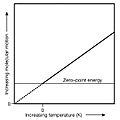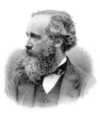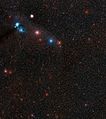Zero-point energy facts for kids
Zero-point energy is the energy of the vacuum space, the space between the subatomic particles within atoms. There are a few theories about how much energy there is in that space. There is the theory that there is an incredibly small, very near-zero amount, the theory that there is zero energy there, the theory that the amount of energy is indeterminable, and the theory that a cubic centimetre of vacuum has a few levels of magnitude more energy than would be required to create the Big Bang.
If you look at the way physics is going, there are atoms, then there are subatomic particles making up atoms (e.g. electrons, protons, neutrons), then further subatomic particles making up those subatomic particles (e.g. quarks, gluons), and now there is string theory. String theory says that those smallest subatomic particles are made of vibrating strings of energy, and that those strings have practically no actual width whatsoever. So all the matter of the universe could be compressed into an extremely small space, hence the Big Bang theory. If this is the case, the large energy interpretation of zero-point energy seems likely.
The term "zero-point" comes from the cooling of helium to 0 kelvin. Even at fractions below 1 Kelvin, the helium stays fluid with no signs of freezing.
Images for kids
-
Liquid helium retains kinetic energy and does not freeze regardless of temperature due to zero-point energy. When cooled below its Lambda point, it exhibits properties of superfluidity
-
Planck in 1918, the year he received the Nobel Prize in Physics for his work on quantum theory
-
imeline of the metric expansion of space. On the left, the dramatic expansion occurs in the inflationary epoch.
See also
 In Spanish: Energía del punto cero para niños
In Spanish: Energía del punto cero para niños











